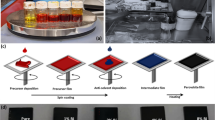Abstract
Perovskites solar cells have reached impressive efficiencies (22%) in recent years. Because certain environmental concerns are raised by the use of lead halides, there is an interest to seek out lead-free alternatives, featuring bismuth or antimony. Alongside, one of the major drawbacks displayed by MAPbI3 is their low stability at ambient conditions. In this work, (RP4)xBiyIz were synthesized, using different types of tetra-alkylphosphoniums (R4PI) were R = ethyl, butyl, hexyl, and octyl, to assess their stability. Afterwards, they were characterized to study their morphology and crystal structure, as well as their optical properties.





Similar content being viewed by others
References
Efficiency chart NREL, https://www.nrel.gov/pv/assets/images/efficiency-chart.pngpv/assets/images/efficiency-chart.png.
S. Colella, E. Mosconi, P. Fedeli, A. Listorti, F. Gazza, F. Orlandi, P. Ferro, T. Besagni, A. Rizzo, G. Calestani, G. Gigli, F. De Angelis, and R. Mosca: MAPbI3—x Cl x mixed halide perovskite for hybrid solar cells: the role of chloride as dopant on the transport and structural properties. Chem. Mater. 25, 4613 (2013).
G. Hodes: Perovskite-based solar cells. Science 342, 317 (2013).
H.J. Snaith: Perovskites: the emergence of a new era for low-cost, high-efficiency solar cells. J. Phys. Chem. Lett. 4, 3623–3630 (2013).
T. Song, Q. Chen, H.H.-P. Zhou, C. Jiang, H.-H. Wang, Y. (Michael) Yang, Y. Liu, J. You, Y. Yang, Y. Liu, J. You, Y. (Michael) Yang, Y. Liu, J. You, and Y. Yang: Perovskite solar cells: film formation and properties. J. Mater. Chem. A 3, 9032 (2015).
X. Zhang, X. Ren, B. Liu, R. Munir, X. Zhu, D. Yang, J. Li, Y. Liu, D. Smilgies, R. Li, Z. Yang, T. Niu, X. Wang, A. Amassian, K. Zhao, and S.F. Liu: Stable high efficiency two-dimensional perovskite solar cells via cesium doping. Energy Environ. Sci. 10, 2095 (2017).
H. Tan, A. Jain, O. Voznyy, X. Lan, F.P. García de Arquer, J.Z. Fan, R. Quintero-Bermudez, M. Yuan, B. Zhang, Y. Zhao, F. Fan, P. Li, L.N. Quan, Y. Zhao, Z.-H. Lu, Z. Yang, S. Hoogland, and E.H. Sargent: Efficient and stable solution-processed planar perovskite solar cells via contact passivation. Science 355, 722 (2017).
Z. Wang, Q. Lin, F.P. Chmiel, N. Sakai, L.M. Herz, and H.J. Snaith: Efficient ambient-air-stable solar cells with 2D-3D heterostructured butylammonium-caesium-formamidinium lead halide perovskites. Nat. Energy 6, 17135 (2017).
D.B. Mitzi: Organic-inorganic perovskites containing trivalent metal halide layers: the templating influence of the organic cation layer. Inorg. Chem. 39, 6107 (2000).
D.B. Mitzi and P. Brock: Structure and optical properties of several organic-inorganic hybrids containing corner-sharing chains of bismuth iodide octahedra. Inorg. Chem. 40, 2096 (2001).
U.H. Hamdeh, R.D. Nelson, B.J. Ryan, U. Bhattacharjee, J.W. Petrich, and M.G. Panthani: Solution-processed BiI3 thin films for photovoltaic applications: improved carrier collection via solvent annealing. Chem. Mater. 28, 6567 (2016).
R.E. Ramírez and E.M. Sánchez: Molten phosphonium iodides as electrolytes in dye-sensitized nanocrystalline solar cells. Sol. Energy Mater. Sol. Cells 90, 2384 (2006).
R.E. Del Sesto, C. Corley, A. Robertson, and J.S. Wilkes: Tetraalkylphosphonium-based ionic liquids. J. Organomet. Chem. 690, 2536 (2005).
R.E. Ramírez, L.C. Torres-González, and E.M. Sánchez: Electrochemical aspects of asymmetric phosphonium ionic liquids. J. Electrochem. Soc. 154, B229 (2007).
K.J. Fraser and D.R. MacFarlane: Phosphonium-based ionic liquids: an overview. Aust. J. Chem. 62, 309 (2009).
R.E. Ramírez-Garcia and E.M. Sánchez-Cervantes: Desarrollo de nuevos electrolitos con potencial uso en celdas solares nanocristalinas. Cien. UANL X, 400 (2007).
R.E. Ramírez, L.C. Torres-González, A. Hernández, A. García, and E.M. Sánchez: Conductivity and viscosity behavior of asymmetric phosphonium iodides. J. Phys. Chem. B 114, 4271 (2010).
A. Banerjee, R. Theron, and R.W.J. Scott: Highly stable noble-metal nanoparticles in tetraalkylphosphonium ionic liquids for in situ catalysis. ChemSusChem 5, 109 (2012).
M.F. Mostafa, A.S. Atallah, and M. Elessawi: Preparation and characterization of a new series of perovskite-like structures showing evidence of structural transitions: (methyltriphenylphosphonium)2BX4, B = Mn, Co, Cu, and Hg, and X = CI/I. Phase Transit. 64, 215 (1998).
M.F. Mostafa and A.S. Atallah: Permittivity and ac conductivity study of the layered perovskite [(CH3) (C6H5)3P]2MnCl4 showing evidence of phase transition. Phys. Lett. A 264, 242 (1999).
M. Schluter, M.L. Cohen, S.E. Kohn, and C.Y. Fong: Electronic structure of BiI3. Phys. Status Solidi B 78, 737 (1976).
J. Coates: Interpretation of infrared spectra, a practical approach. Encycl. Anal. Chem. 12, 10815 (2000).
Infrared: Interpretation. https://chem.libretexts.org/Core/Physical_and_Theoretical_Chemistry/Spectroscopy/Vibrational_Spectroscopy/Infrared_Spectroscopy/Infrared%3A_InterpretationCore/Physical_and_Theoretical_Chemistry/Spectroscopy/Vibrational_Spectroscopy/Infrared_Spectroscopy/Infrared%3A_Interpretation .
D.A. Skoog, F. James Holler, and T. A. Nieman: Principios de análisis instrumental, 5ta Edición (McGraw Hill, Madrid, 2001), p. 409.
W. Clegg, R.J. Errington, G.A. Fisher, M.E. Green, D.C.R. Hockless, and N.C. Norman: A phosphine complex of bismuth(III): X-ray crystal structure of [PMe3H] [Bi2Br7(PMe3)2]. Chem. Ber. 124, 2457 (1991).
A. Altomare, C. Cuocci, C. Giacovazzo, A. Moliterni, R. Rizzi, N. Corriero, and A. Falcicchio: EXPO2013: a kit of tools for phasing crystal structures from powder data. J. Appl. Crystallogr. 46, 1231 (2013).
D. Winn and M.F. Doherty: Modeling crystal shapes of organic materials grown from solution. AlChE J. 46, 1348 (2000).
Acknowledgments
The authors acknowledge the financial support received through the projects 256766 CONACYT-SENER and CONACyT-FC-2015-2-1252.
Author information
Authors and Affiliations
Corresponding author
Rights and permissions
About this article
Cite this article
Garcia-Gutierrez, D.F., Garcia-Gutierrez, D.I., González-Quijano, D. et al. Improving ambient stability of BiI3-based perovskites using different phosphoniums as the organic cation. MRS Communications 8, 878–884 (2018). https://doi.org/10.1557/mrc.2018.86
Received:
Accepted:
Published:
Issue Date:
DOI: https://doi.org/10.1557/mrc.2018.86




